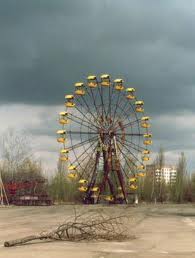The Chernobyl disaster was a catastrophic nuclear accident that occurred on 26 April 1986 at the Chernobyl Nuclear Power Plant in Ukraine, which was under the direct jurisdiction of the central authorities in Moscow. An explosion and fire released large quantities of radioactive contamination into the atmosphere, which spread over much of Western USSR and Europe. It is widely considered to have been the worst nuclear power plant accident in history, and is one of only two classified as a level 7 event on the International Nuclear Event Scale. The battle to contain the contamination and avert a greater catastrophe ultimately involved over 500,000 workers and cost an estimated 18 billion rubles, crippling the Soviet economy.
The disaster began during a systems test on Saturday, 26 April 1986 at reactor number four of the Chernobyl plant, which is near the city of Prypiat and in close proximity to the administrative border with Belarus and Dnieper river. There was a sudden power output surge, and when an emergency shutdown was attempted, a more extreme spike in power output occurred, which led to a reactor vessel rupture and a series of explosions. These events exposed the graphite moderator of the reactor to air, causing it to ignite. The resulting fire sent a plume of highly radioactive smoke fallout into the atmosphere and over an extensive geographical area, including Pripyat. The plume drifted over large parts of the western Soviet Union and Europe. From 1986 to 2000, 350,400 people were evacuated and resettled from the most severely contaminated areas of Belarus, Russia, and Ukraine. According to official post-Soviet data, about 60% of the fallout landed in Belarus.
The accident raised concerns about the safety of the Soviet nuclear power industry, as well as nuclear power in general, slowing its expansion for a number of years and forcing the Soviet government to become less secretive about its procedures. The government coverup of the Chernobyl disaster was a "catalyst" for glasnost, which "paved the way for reforms leading to the Soviet collapse."
Russia, Ukraine, and Belarus have been burdened with the continuer and an estimated total of 3940 deaths from radiation-induced cancer and leukemia.
The Union of Concerned Scientists estimates that, among the hundreds of millions of people living in broader geographical areas, there will be 50,000 excess cancer cases resulting in 25,000 excess cancer deaths. For this broader group, the 2006 TORCH report predicts 30,000 to 60,000 excess cancer deaths, and a Greenpeace report puts the figure at 200,000 or more.
The Russian publication Chernobyl, which has received criticism for its methodology and sourcing, concludes that among the billions of people worldwide who were exposed to radioactive contamination from the disaster, nearly a million premature cancer deaths occurred between 1986 and 2004.








No comments:
Post a Comment